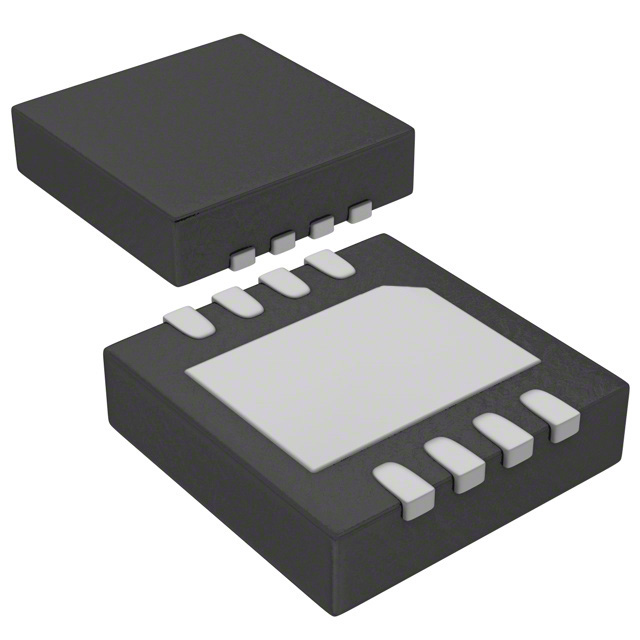Viz Specifikace pro podrobnosti o produktu.

ADM7150ACPZ-3.3-R7
Basic Information Overview
- Category: Integrated Circuit (IC)
- Use: Voltage Regulator
- Characteristics: Low Dropout, High PSRR, Low Noise
- Package: LFCSP (Lead Frame Chip Scale Package)
- Essence: Linear Regulator
- Packaging/Quantity: Tape and Reel, 3000 pieces per reel
Specifications
- Input Voltage Range: 2.5V to 6.5V
- Output Voltage: 3.3V
- Output Current: Up to 150mA
- Dropout Voltage: 200mV at 100mA
- PSRR (Power Supply Rejection Ratio): 70dB at 1kHz
- Noise: 30µV RMS (Root Mean Square) from 10Hz to 100kHz
- Quiescent Current: 50µA typical
- Operating Temperature Range: -40°C to +125°C
Detailed Pin Configuration
The ADM7150ACPZ-3.3-R7 has the following pin configuration:
| Pin Number | Pin Name | Description | |------------|----------|-------------| | 1 | VIN | Input Voltage | | 2 | GND | Ground | | 3 | EN | Enable Pin | | 4 | BYP | Bypass Capacitor Connection | | 5 | FB | Feedback Voltage | | 6 | VOUT | Output Voltage |
Functional Features
- Low dropout voltage enables operation with low input-output voltage differentials.
- High power supply rejection ratio ensures stable output voltage even in noisy environments.
- Low output noise makes it suitable for noise-sensitive applications.
- Enable pin allows for easy on/off control of the regulator.
- Bypass capacitor connection improves transient response and stability.
Advantages
- Wide input voltage range allows for flexibility in various applications.
- Low dropout voltage minimizes power dissipation and extends battery life.
- High PSRR ensures reliable performance in noisy environments.
- Low output noise makes it suitable for audio and sensitive analog applications.
- Enable pin provides convenient control over the regulator's operation.
- Bypass capacitor connection enhances stability and transient response.
Disadvantages
- Limited output current may not be sufficient for high-power applications.
- LFCSP package may require specialized handling during assembly.
- Higher cost compared to some other voltage regulators with similar specifications.
Working Principles
The ADM7150ACPZ-3.3-R7 is a linear regulator that uses a pass transistor to regulate the output voltage. It operates by comparing the feedback voltage (FB) with a reference voltage to adjust the pass transistor's resistance and maintain a stable output voltage. The enable pin (EN) controls the regulator's on/off state, while the bypass capacitor (BYP) improves stability and transient response.
Detailed Application Field Plans
The ADM7150ACPZ-3.3-R7 is commonly used in various applications, including: 1. Battery-powered devices: Portable electronics, handheld instruments, and wireless sensors. 2. Industrial equipment: Control systems, data acquisition modules, and motor drives. 3. Communication systems: Wireless routers, access points, and network switches. 4. Audio systems: Headphone amplifiers, audio DACs, and preamplifiers. 5. Automotive electronics: Infotainment systems, navigation units, and dashboard displays.
Detailed and Complete Alternative Models
Some alternative models to the ADM7150ACPZ-3.3-R7 include: 1. LT1763-3.3: Low dropout linear regulator with similar specifications. 2. TPS7A3301: Ultra-low noise linear regulator with adjustable output voltage. 3. MCP1703: Low dropout voltage regulator with various output voltage options. 4. MAX6033: Low quiescent current linear regulator with low dropout voltage. 5. LM1117-3.3: Popular linear regulator with adjustable and fixed output voltage options.
(Note: The above list is not exhaustive and serves as a reference for alternative models.)
This encyclopedia entry provides an overview of the ADM7150ACPZ-3.3-R7 voltage regulator, including its basic information, specifications, pin configuration, functional features, advantages, disadvantages, working principles, application field plans, and alternative models.
Seznam 10 běžných otázek a odpovědí souvisejících s aplikací ADM7150ACPZ-3.3-R7 v technických řešeních
Sure! Here are 10 common questions and answers related to the application of ADM7150ACPZ-3.3-R7 in technical solutions:
Q: What is the ADM7150ACPZ-3.3-R7? A: The ADM7150ACPZ-3.3-R7 is a voltage regulator IC (integrated circuit) that provides a regulated output voltage of 3.3V.
Q: What is the input voltage range for the ADM7150ACPZ-3.3-R7? A: The input voltage range for the ADM7150ACPZ-3.3-R7 is typically between 2.7V and 5.5V.
Q: What is the maximum output current of the ADM7150ACPZ-3.3-R7? A: The ADM7150ACPZ-3.3-R7 can provide a maximum output current of 500mA.
Q: How does the ADM7150ACPZ-3.3-R7 handle thermal management? A: The ADM7150ACPZ-3.3-R7 has built-in thermal shutdown and current limit protection features to prevent overheating and ensure safe operation.
Q: Can the ADM7150ACPZ-3.3-R7 be used in battery-powered applications? A: Yes, the ADM7150ACPZ-3.3-R7 can be used in battery-powered applications as it operates within a wide input voltage range and has low quiescent current.
Q: Does the ADM7150ACPZ-3.3-R7 require any external components for operation? A: Yes, the ADM7150ACPZ-3.3-R7 requires a few external components such as input and output capacitors for stability and filtering.
Q: What is the typical dropout voltage of the ADM7150ACPZ-3.3-R7? A: The typical dropout voltage of the ADM7150ACPZ-3.3-R7 is around 200mV at full load.
Q: Can the ADM7150ACPZ-3.3-R7 be used in automotive applications? A: Yes, the ADM7150ACPZ-3.3-R7 is suitable for automotive applications as it meets the necessary automotive standards and has a wide input voltage range.
Q: Is the ADM7150ACPZ-3.3-R7 available in other output voltage options? A: Yes, the ADM7150ACPZ series is available in various output voltage options, including 1.2V, 1.5V, 1.8V, 2.5V, and 3.3V.
Q: What are some typical applications for the ADM7150ACPZ-3.3-R7? A: The ADM7150ACPZ-3.3-R7 can be used in a wide range of applications such as industrial automation, telecommunications, consumer electronics, and portable devices where a regulated 3.3V power supply is required.
Please note that these answers are general and may vary depending on specific application requirements.

